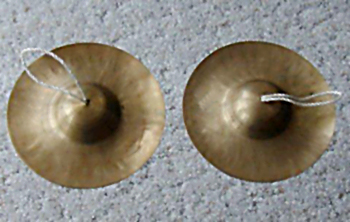 Cymbals are percussion instruments that belong to the family of idiophones, i.e., they produce ringing from themselves. The cymbal is a circular flat or concave metal plate that is either struck with a drumstick or used in pairs struck together. Cymbals date back to ancient times and are found in almost all cultures. They were used mostly for ritualistic purposes. They have been known to have been used in Assyria, Israel, Egypt and other ancient civilisations and reached East Asia in medieval times and Europe before the 13th century. The cymbal (metsiltayim for the pair of cymbals and zilzal for the single cymbal) is even mentioned in the Bible and was played in the Solomon`s temple. The Egyptians, Greeks, and Romans knew and used cymbals as well, but chiefly the smaller forms.
Cymbals are percussion instruments that belong to the family of idiophones, i.e., they produce ringing from themselves. The cymbal is a circular flat or concave metal plate that is either struck with a drumstick or used in pairs struck together. Cymbals date back to ancient times and are found in almost all cultures. They were used mostly for ritualistic purposes. They have been known to have been used in Assyria, Israel, Egypt and other ancient civilisations and reached East Asia in medieval times and Europe before the 13th century. The cymbal (metsiltayim for the pair of cymbals and zilzal for the single cymbal) is even mentioned in the Bible and was played in the Solomon`s temple. The Egyptians, Greeks, and Romans knew and used cymbals as well, but chiefly the smaller forms.
Cymbals are most often constructed out of bronze. The dimensions can vary widely. Cymbals are used in pairs as well as singly. There are a number of different types of cymbals which are in popular use. There are large types, in which one is held in each hand, but there are also miniature cymbals that are worn on the fingers. In Western music, the large cymbals are more common in both symphony orchestras and percussion groups, and in brass and marching bands. Western orchestral cymbals derive from those used in the Turkish military bands in vogue in 18th-century Europe. In modern popular music, the cymbal is a component of the drum set, in which the single cymbal is attached to a stand and struck with sticks of all different shapes and sizes, from hard to soft.
The various basic forms of the cymbal include the Turkish cymbal and the Chinese cymbal. The former is a slightly convex shaped cymbal with a smooth surface. Toward the center, the surface bulges into a sort of inverted bowl, in which the hole for hanging the cymbal can be found. The Chinese cymbal is slightly convex in shape and arched. The edge is turned slightly upward and towards the centre the cymbal bulges into a kettle-shaped protrusion on which the hanging point is to be found. The modern orchestra cymbal is relatively flat, though very slightly convex, and has a diameter of up to 24 inches. Most Asian cymbals are either broad-rimmed, with or without a dome (boss), held horizontally, and clashed loudly, or small-rimmed (or rimless), held vertically, and played softly. Finger cymbals are miniature cymbals, attached to the thumb and index finger. These are most often used in Spanish and Islamic music. When the thumb and index finger are struck against each other, a short, sharp tone is produced. Cymbales antiques are a related form. They are larger and are played with both hands. When the player strikes the cymbales antiques against each other in a certain way, a specific note can be struck. The large Indonesian cymbals known as ceng-ceng whose name is onomatopoeic make a distinctive sound.
The large cymbals can be played in three ways. In one, the cymbals are horizontally clashed against each other, and in another, the cymbals arc slid vertically past each other, brushing against each other. Sometimes a single cymbal is struck with a stick. The cymbal can also be struck using brushes of a springy material that the drummer can use in a sweeping or striking motion. Hi-hat cymbals are of a special type, consisting of two cymbals mounted on a stand in such a way that one cymbal that is pedal-operated, is clashed against the other, mounted in a fixed position. The sizzle cymbals have small holes in the rim that contain loose rivets. When the cymbals are struck, the rivets produce a high, rushing sound.
In Indian music, the most commonly used cymbals are small in size. More precisely they are a set of small cymbals. It is a very important part of dance music and Bhajans. The use of cymbals dates back to ancient times. Examples are seen on the temple walls, dating back to the earliest of times. They were used to accompany the dance of the Bayaderes, priestesses who danced only in the temples. The Indian cymbals are usually made of brass. The most commonly used cymbal in India is the Manjira. It is also called jhanj, tala, mondira, (small size) kafi (large size), or a host of other names. The most common use of the manjira is seen in bhajan, folk music, and the dance forms of Bharatnatyam, Kuchipudi, Manipuri, Mohiniattam, Andhra Natyam and Kathakali.




